Jigging in Norway
The Fjords of Norway are a spectacular place to visit, often offering the
travelling angler an abundance of fish to catch using a variety of methods.
I have detailed below some of the different fishing techniques that have proven
successful for me.
Pirking / Jigging
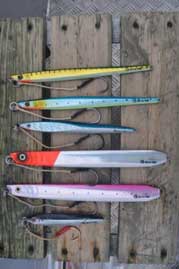
My early experiences in these waters were mostly limited to working heavy
400gram+ Pirks with very large treble hooks switching over occasionally to use a
large rubber Shad. Whilst these methods are effective and have proven very
productive for me in the past, anyone who has constantly worked a heavy pirk all
day in deep water will tell you “it’s Hard Work”.
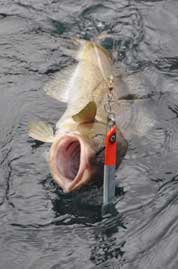
On my more recent trips I have adapted
to using Fast Drop Vertical Jigs combined with an Assist hook instead of a
Treble Hook and here are my findings;
# Using Vertical Jigs alongside Traditional Pirks proved equally effective
resulting in the same number of fish for each method, # Vertical Jigs “fast
drop” to the strike zone much quicker than Pirks thus allowing me to fish much
lighter with less effort and therefore more enjoyment.
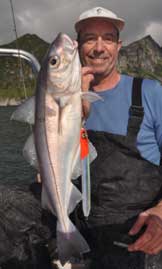
# An Assist hook creates less drag on the Jig which also speeds up the descent
compared to a large Treble Hook.# An Assist Hook-up is mostly a clean one which
enables the fish to be returned to the water with minimal damage,
# Large Trebles result in a much higher number of Foul Hooked fish, which can
become tiring for the angler and bad news for the fish.
I work the Vertical Jigs the same way as you would lift and drop a pirk, most
importantly keeping as near a vertical line to the jig as possible. If wind or
tide is creating too much drift to maintain this vertical line then try a gentle
underarm cast against the drift and the jig should be more vertical
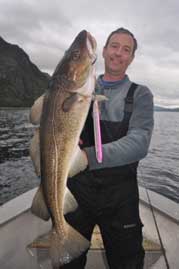 once it has reached the strike zone.
If this fails then try a heavier jig or seriously consider moving position
because unless this angle is achieved you cannot impart the correct action on
the jig and your strike rate will be dramatically reduced. NB. Something to note
is that Tackle Loss in Norway is almost zero so you don’t need dozens of Jigs,
in all of my visits I have lost just one Jig as it got entangled in an abandoned
fishing net.
once it has reached the strike zone.
If this fails then try a heavier jig or seriously consider moving position
because unless this angle is achieved you cannot impart the correct action on
the jig and your strike rate will be dramatically reduced. NB. Something to note
is that Tackle Loss in Norway is almost zero so you don’t need dozens of Jigs,
in all of my visits I have lost just one Jig as it got entangled in an abandoned
fishing net.
Spinning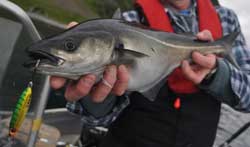
If you like the lighter tackle approach then you should definitely arm yourself
with a light to medium weight spinning outfit to target the shoals of Coalfish
that are easy to find once you find sea birds working the water.
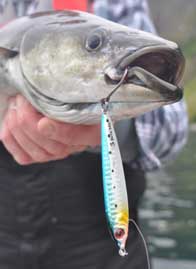 Cast a small jig in their direction,
let it sink a little and then jerk the rod holding it horizontally to the water
whist reeling in to impart a darting motion on the jig, then hold on as the
battle begins. Believe me a 5lb+ Coalie will offer great sport on this lighter
outfit.
Cast a small jig in their direction,
let it sink a little and then jerk the rod holding it horizontally to the water
whist reeling in to impart a darting motion on the jig, then hold on as the
battle begins. Believe me a 5lb+ Coalie will offer great sport on this lighter
outfit.
Rubber Shads
It is certainly worth dropping down a large 9inch Shad and winding it slowly
back to the boat. This method can be deadly if the Halibut are around and often
singles out the larger size Cod. Be vigilant whist lowering the Shad and always
be ready to thumb the spool as Halibut will often take on the drop before diving
to the bottom. Contrary to some people’s belief, halibut do not restrict their
feeding habits to hunting on the sea bed; they commonly take a Shad quite near
the boat so be sure to fish the full water column.